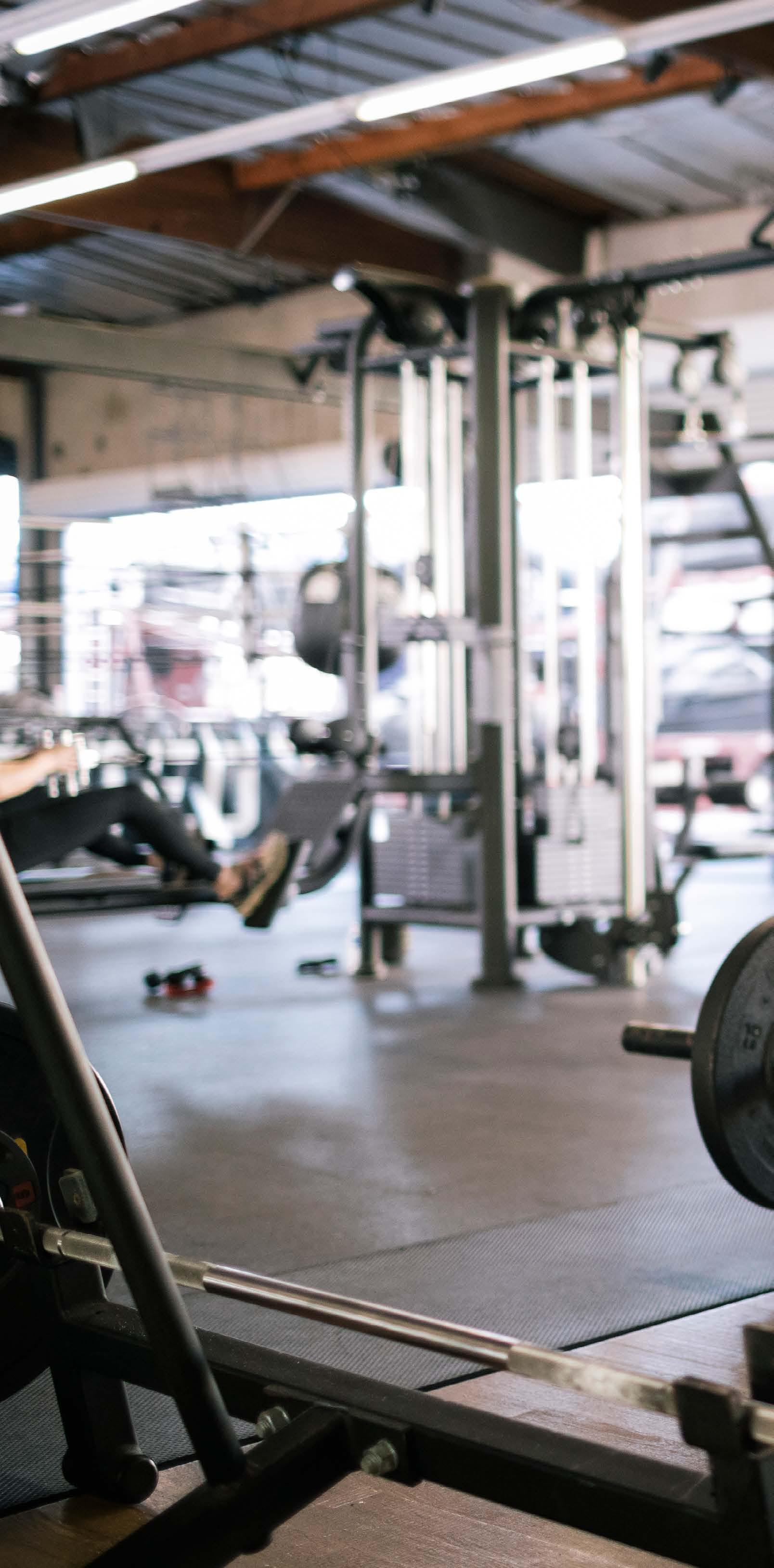
12 minute read
STRONG Camp
Train To LEAN STRONG CAMP:

Advertisement
The regular STRONG Camp feature will have some of Australia’s most knowledgeable and experienced trainers provide their advice on a training topic set by the Editor.
WHEN IT COMES TO SHEDDING THE KILOS, CREATING A CALORIE DEFICIT IS KING, SO GETTING YOUR NUTRITION IN CHECK IS PARAMOUNT. BUT WHAT ELSE CAN WE DO IN-GYM TO FAST-TRACK FAT LOSS?
RAWDAH When aiming to lose body fat, the first consideration is energy balance. It’s a little more complicated than that, but unless you nail this principle first, you’re going to be disappointed. You also need to be clear: fat loss and weight loss are not the same thing. Fat loss means you are reducing the amount of body fat you have; weight loss means you are losing something that makes you lighter on the scales – be it fat, muscle, glycogen, a big bowel movement, water, or something else. If you reached your weight loss goal, but the bulk of it came from muscle, would you be happy? Probably not. You know that fat can only be reduced by eliciting a calorie deficit – aka eating fewer calories than you need to maintain weight – but you must be wary of the catabolic environment you’re entering into; an environment that increases your risk of muscle loss. If fat loss really is your goal, you need to reduce this risk and encourage your body to take adipose tissue (fat) as its casualties – not the muscle you’ve worked so hard for. How do you reduce this risk? By understanding the three pillars for preventing muscle loss:
1. Calorie deficit: Eating in enough of a calorie deficit to create the result you’re after, but not so much that your risk is exponential – 10 to 25 per cent below total daily energy expenditure (TDEE) is ideal. TDEE is approximately your bodyweight in kilograms multiplied by 30, depending on how lean and active you are.
2. Protein: Consuming adequate protein – anywhere from 1.8 to three grams of protein per kilogram of body weight.
3. Training: Resistance train at a high enough frequency and intensity: 50 to 80 working sets over the week, and with a maximum RIR (reps in reserve) of four per working set. Resistance training is an important contributor to LBM (lean body mass) retention and plays a key role in maintaining muscle when fat loss is the goal. Many women change their resistance training regime to focus less on strength in order to ‘burn fat’ – or swap it entirely for cardio – enhancing their risk of muscle loss. If weight loss stalls and you don’t want to reduce calorie consumption further, increasing calorie expenditure can be done through added movement, such as a daily step target. But remember: this is in addition to your resistance exercise, not instead of it.
LIZZY RAWDAH CO-DIRECTOR FLEX SUCCESS flexsuccess.com.au // @flex_success Lizzy has been in the health and fitness industry since 2008: first as a personal trainer and group fitness instructor, before moving online in 2014 as Co-Director of coaching business Flex Success. She is accredited through Beck Health & Nutrition, is a qualified Master Trainer through the Australian Institute of Fitness, holds a Bachelor of Social Science degree, and broke an Australian record in Strongman in 2017. Lizzy works with both general population clients and performance athletes, using an evidence-based, individualised and practical approach to healthy, sustainable results.
SOFIA TOUMBAS TRAINER & INDUSTRY EDUCATOR @sofiatoumbas
Sofia holds a Diploma of Fitness and a Post Graduate Diploma of Education, and has been a qualified Personal Trainer for over 10 years. An avid bikini competitor, Sofia now spends her days educating the wider industry and coaching an intimate group of sport specific clients online.
TOM FITZGERALD EXERCISE SCIENTIST & NUTRITIONIST integratedfitnessnutrition.com // @tomfitzgerald.ifn Tom is a Nutritionist and Exercise Scientist based in Kingscliff, NSW. Specialising in general population body recomposition clients, Tom now runs his own coaching business, Integrated Fitness Nutrition. On top of his Sport Coaching and Exercise Science and Human Nutrition degrees, he’s also a certified Sports Nutritionist through the International Society of Sports Nutrition.
TRAVIS JONES FOUNDER – RESULT BASED TRAINING GYMS rbtgyms.com // @travisjonesentrepreneur Travis is the Founder of 15+ Result Based Training (RBT) Gyms across Australia, and health and fitness tracking app, Keystone Health and Fitness. Jones, who played elite level rugby league as a teenager until his early 20s, has over 15 years of experience in the industry. He has completed his Poliquin Level 3 and FMA Strength Institute Level 3, and is an AOK Health Corrective Exercise Specialist.
TOUMBAS There are general methods that are universally considered as effective methods of training for fat loss, including high intensity training and heavy weight training, coupled with structured nutrition. But there are a few specific applications that will ensure most, if not all, types of bodies get the most out of their sessions to achieve their fat loss goals. 1. Training quality: If you don’t approach your program with the intention of absolutely pushing your limits, there will be little adaptation and the potential to burn the maximum amount of calories is diminished. I ask my clients to focus on performing a quality training session to the limits that their body is capable of on that day. For example, the goal is to make the last three to four reps as difficult as possible, usually to a 9.8 perceived rate of exertion (on a scale of one to 10). This is also contingent on how the client is feeling on any given day. What felt like a nine out of 10 last week, could feel like a 20/10 the following week. This client may have to reduce weight, but the intensity remains the same.
2. Training variety: There is a lot of hype about high intensity training styles where clients can optimise excess postexercise oxygen consumption (EPOC) to boost metabolism post sessions. This method can be effective, but shouldn’t be the primary method for fat loss. Understanding how different styles of training affect the body systems is key, and varying your training program can help get you results faster and more effectively. For example, strength training will promote lean muscle growth (which will promote greater fat loss over the long term), and then a high-intensity interval training (HIIT) finisher will add the benefits of EPOC.
3. Change your approach: Planning or ‘periodising programs’ ensures fat loss is consistent. The body adapts to all training pressures, so rotating training styles will prevent the body getting too comfortable with one style (plateau). Performing four to six-week training cycles derived from strength hypertrophy and conditioning training will induce fat loss and develop a holistically strong and healthy body. An example may be a phase one (preparation) – where you will perform push/pull splits for moderate rep ranges and sets for four weeks – before you enter into phase two (strength), where the reps drop, weights are heavier, and the sets increase to maintain volume. Plus, incorporating accessory exercises that will improve the main lifts. Coupled with a caloric deficit, these strategies will induce fat loss while maintaining lean muscle and performance.


4. Exercise selection: To increase fat loss, select exercises that elicit the greatest response in the shortest amount of time. Multi-joint, compound exercises that use multiple muscle groups will elicit higher caloric expenditure. Prioritise the ‘big lifts’ such as the squat, deadlift, bench press and row variations, as they all require more energy to perform, especially at heavy exertion. Single-joint exercises such as bicep curls and glute clams should only be used as accessories to build those specific muscles that require growth. The key is to keep challenging the body through applying a variety of programming techniques, build lean muscle mass to improve the body’s ability to metabolise, and ensure more effective exercises are being performed to produce these results. With these in play, your body will have no other choice but to melt the fat.
FITZGERALD These are three of my favourite strategies to use with clients to make sure their training sessions are effective, efficient and adherable when fat loss is the goal. When a training strategy is manageable and clients are getting fitter and stronger, they are going to turn up to the next session and train harder and progress further. 1. Supersets: Are a great way to get more work done in a fixed period of time. I prefer to pair opposing muscle groups together, instead of pairing similar muscle groups such as push-ups and chest flyes. Since my clients tend to train upper or lower body splits, I superset push and pull movements, such as push-ups with reverse flyes. This allows us to take advantage of the efficiency of supersets and increase the load on both exercises. In a same-group superset, fatigue from the first exercise will limit output on the second exercise. Using opposing muscle groups limits this and allows greater performance across the session.
2. Steady has a place: Continuous moderate-intensity exercise (CME) (e.g. 45-minute jog upwards of 60 to 70 per cent maximum heart rate) took a back seat as HIIT increased in popularity over the past few years. However, CME plays a vital role in developing training programs to support fat loss. My clients use a range of CME activities such as running, cycling and swimming. While two minutes of CME burns less energy than two minutes of HIIT, CME can be done for a longer duration and leads to greater overall energy expenditure. Plus, resistance training is already a form of interval training, so including CME helps to create a well-rounded training program. CME also leads to more tangible progress for the client, such as increased distance or decreased time to completion, which can help motivation and adherence. My clients tend to enjoy being able to run an extra five kilometres more than doing an extra five burpees in a minute.


3. Improve every session: The most important tip for a fat loss training strategy is to have the intent of getting fitter and stronger from each session. Fat loss is driven by an energy deficit – more energy expended than consumed – but if you start thinking about your training as only a calorie-burning mechanism, you will quickly become disillusioned with the sessions. My clients use some low-moderate rep schemes to increase strength in the gym, and help their CME to go for longer or harder. Many people make the mistake of cutting calories too low and it impacts their ability to train hard. While it might lead to rapid fat loss initially, a decrease in training intensity and adherence can cause a plateau soon after. A better option is to create an energy deficit while maintaining the intent to gain.
JONES When it comes to fat loss, the two cornerstones of any successful transformation are how much we eat and the exercise we do. We can all ‘lose fat’ – it’s keeping it off that is the hard part. Setting my clients and members up with a training plan that induces maintainable fat loss is key. Through my experience, research and adaptive coaching style, I’ve blended a mix of strength and resistance training in tandem with interval training. So my top tips for building a training program to optimise fat loss would be: 1. Resistance: We use resistance training as a ‘base’ to develop the confident and safe movement patterns to support a foundation of strength. The more weight we can move, the more calories will then be burned – both during the session and up to several days after. Resistance training also increases your lean muscle – potent metabolic furnaces that can increase your calorie burn, allowing you more flexibility in your meal plans. In my opinion, this is the secret to sustainable body transformations.

2. Interval training: When compared, interval training has been shown to be significantly better for fat loss than steady state cardio – plus, I find it gives clients the ‘sweat is fat crying’ feeling without the boredom of unnecessarily pounding the pavement for hours.
3. Three-week training blocks: Give you enough time to create improvements via progressive overload, but not to adapt to the program and stall. Too long, and you will not have enough variety and psychologically you’ll want to stop following the program.
4. Programming type: My preferred type of programming for females is switching between phases of accumulation (moderate to higher reps and slightly less weight) and intensification (heavier weights for less reps). The accumulation phase is designed to build muscle and the intensification phase is designed to increase strength. S
JONES’ SAMPLE FAT LOSS TRAINING PLAN
If I was going to pick a plan to torch fat and increase strength it would be a 6/12/25 program. This program is designed using a compound movement performed for six reps, and an accessory exercise for 12 to 25 reps to exhaust the muscle group. Lift four times per week, focusing on two upper body days and two lower body days. Your rest days should be focused on active recovery, making sure you hit 12,000 steps.
SPLIT
MON TUE WED THU FRI SAT SUN Lower body Upper body Active rest Lower body Upper body Active rest Active rest
LOWER BODY WORKOUT EXAMPLE
CIRCUIT A 5 SETS Low bar back squat 6 reps (2 RIR) BB reverse lunge 12 reps (each leg) Moderately heavy weight (4 to 6 RIR) DB heels elevated squat 25 reps 90 seconds rest between sets
CIRCUIT B 5 SETS Sumo deadlift 6 reps (2 RIR) BB hip thrust 12 reps moderate to heavy weight (4 RIR) Frog pumps 25 reps bodyweight or (weighted if you can) DB resting on pelvis 90 seconds rest between sets
INTERVAL TRAINING FINISHER
5 ROUNDS 60 second sprint on assault bike 60 second rest with legs still moving slowly
BB = barbell DB = dumbbell RIR = reps in reserve
Next Level Apparel provides garments that are soft, lightweight and form-fitting. They provide the perfect balance between functionand style with great drape, stretch and recovery.











